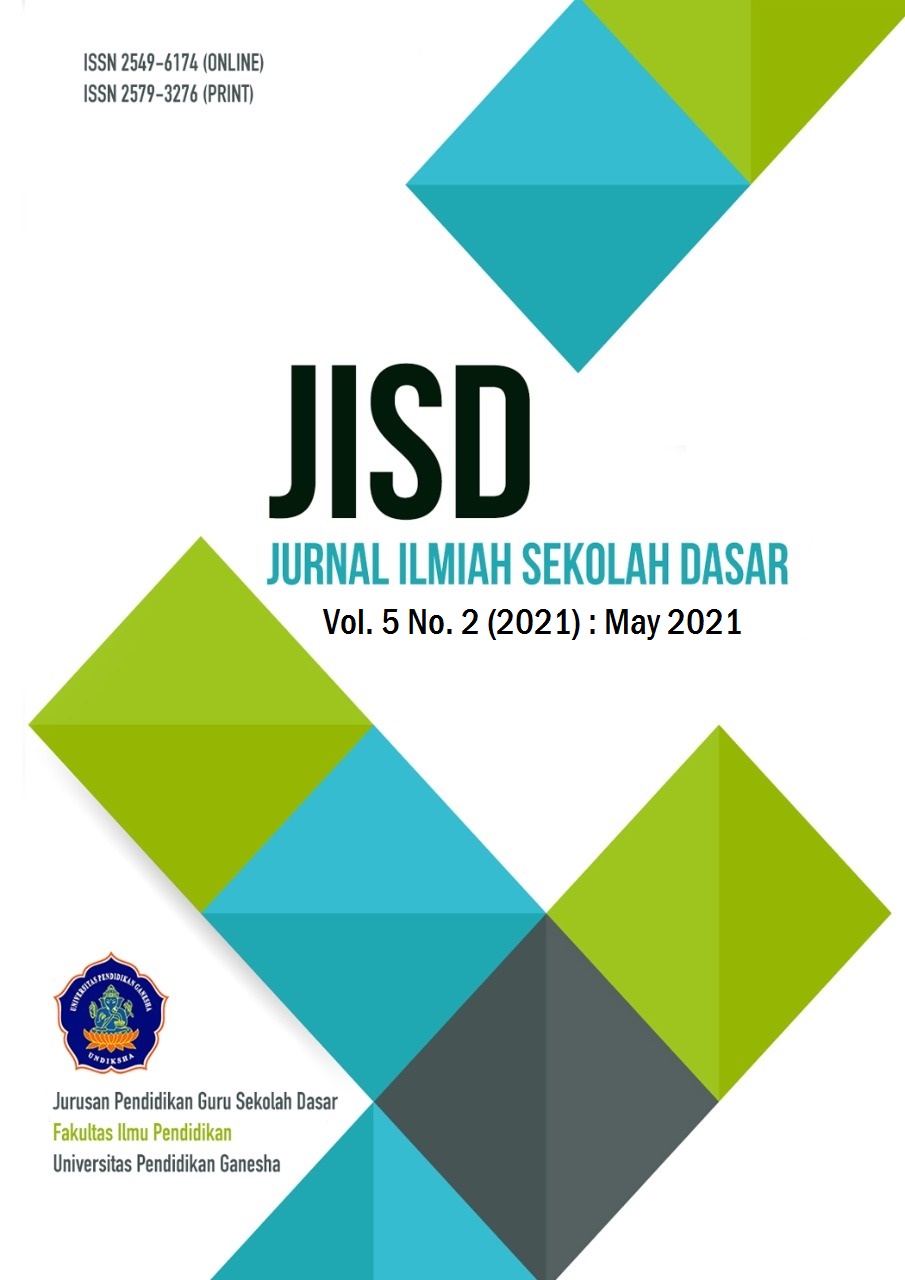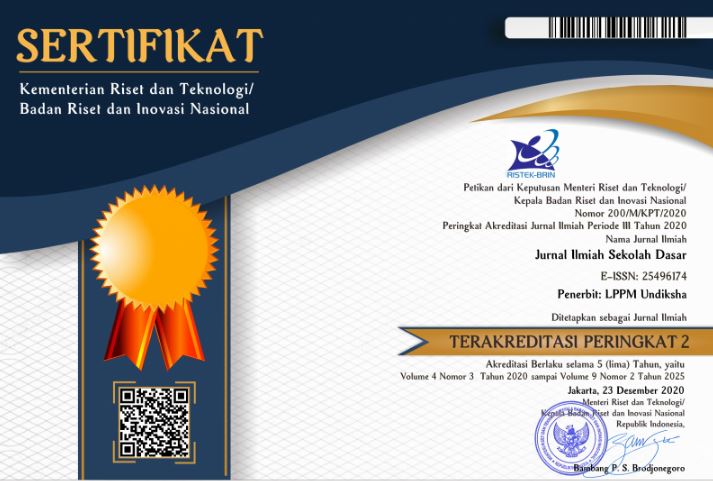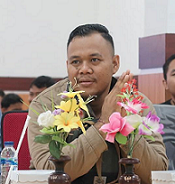Using Zoom to Support English Learning during Covid-19 Pandemic: Strengths and Challenges
DOI:
https://doi.org/10.23887/jisd.v5i2.35006Keywords:
english learning, online Learning, strength and challenge, zoomAbstract
COVID-19 pandemic caused educational institutions apply remote distance learning policy. Zoom is one of popular platforms to optimize online learning through video conference. This study aimed to explore strengths and challenges of using Zoom to support distance English learning. A qualitative approach with narrative inquiry design was employed and students from a junior high school voluntarily participated. Interview was deployed as data collection methods, and the data were validated by triangulation and analyzed by following the interactive model analysis. The study reveals that learning English via Zoom help students to practice English, make teaching-learning process more effective, and facilitate the teacher-student interaction and communication. Moreover, features on Zoom support distance English learning. Those all benefits bring good impact on students’ English learning output. Meanwhile, Zoom is also challenging for students with slow internet connection and unsupported gadget. The activity also spends extra cost for internet bill and need conducive learning environment. It is suggested that government needs to provide better facilities to support online learning, such as providing good internet access.
References
Abdullah, M. Y., Rahamah, N., Bakar, A., & Mahbob, M. H. (2012). The Dynamics of Student Participation in Classroom : Observation on Level and forms of Participation The dynamics of student participation in classroom : observation on level and forms of participation. February 2015. https://doi.org/10.1016/j.sbspro.2012.09.246.
Adila, J. (2019). Students’ Motivation and Attitudes Toward Learning English in an English Course. Journal of Chemical Information and Modeling, 53(9), 1689–1699.
Alfadda, H. A., & Mahdi, H. S. (2021). Measuring Students’ Use of Zoom Application in Language Course Based on the Technology Acceptance Model (TAM). Journal of Psycholinguistic Research, 0123456789. https://doi.org/10.1007/s10936-020-09752-1.
Alshahrani, A. A. (n.d.). Communicating Authentically : E nhancing EFL Students ’ Spoken English via Videoconferencing. 17(2), 1–17.
Archibald, M. M., Ambagtsheer, R. C., Casey, M. G., & Lawless, M. (2019). Using Zoom Videoconferencing for Qualitative Data Collection : Perceptions and Experiences of Researchers and Participants. 18, 1–8. https://doi.org/10.1177/1609406919874596.
Borup, J., West, R. E., & Graham, C. R. (2012). Improving online social presence through asynchronous video. Internet and Higher Education, 15(3), 195–203. https://doi.org/10.1016/j.iheduc.2011.11.001.
Clandinin, D. J. (2006). Research Studies in Music Education. Society for Education, Music and Psychology Research Additional. https://doi.org/10.1177/1321103X060270010301.
Cuaca Dharma, H. R., Asmarani, D., & Dewi, U. P. (2017). Basic Japanese Grammar and Conversation e- learning through Skype and Zoom Online Application. Procedia Computer Science, 116, 267–273. https://doi.org/10.1016/j.procs.2017.10.055.
Dhawan, S. (2020). Online Learning: A Panacea in the Time of COVID-19 Crisis. Journal of Educational Technology Systems, 49(1), 5–22. https://doi.org/10.1177/0047239520934018.
Fadilah, E. (2018). Willingness To Communicate in L2 By Using. 5(1), 23–48.
Gray, J. A., & Diloreto, M. (n.d.). The Effects of Student Engagement , Student Satisfaction , and Perceived Learning in Online Learning Environments. 11(1).
Hu, X., & McGeown, S. (2020). Exploring the relationship between foreign language motivation and achievement among primary school students learning English in China. System, 89, 102199. https://doi.org/10.1016/j.system.2020.102199.
Kristóf, Z. (2020). International Trends of Remote Teaching Ordered in Light of the Coronavirus (COVID- 19) and its Most Popular Video Conferencing Applications that Implement Communication. Central European Journal of Educational Research, 2(2), 84–92. https://doi.org/10.37441/cejer/2020/2/2/7917.
Li, C. (Cecilia). (2016). A survey on Chinese students’ online English language learning experience through synchronous web conferencing classrooms. CALL Communities and Culture – Short Papers from EUROCALL 2016, 2016(2016), 265–270. https://doi.org/10.14705/rpnet.2016.eurocall2016.573.
Lowenthal, P. R., & West, R. E. (2020). Thinking Beyond Zoom : Using Asynchronous Video to Maintain
Connection and Engagement During the COVID-19 Pandemic. 28, 383–391.
Miles, M. B., Huberman, A. M., & Saldaña, J. (n.d.). Qualitative Data Analysis.
Mishra, L., Gupta, T., & Shree, A. (2020). Online teaching-learning in higher education during lockdown period of COVID-19 pandemic. International Journal of Educational Research Open, June, 100012. https://doi.org/10.1016/j.ijedro.2020.100012.
Monica, J., & Fitriawati, D. (2020). Efektivitas Penggunaan Aplikasi Zoom Sebagai Media Pembelajaran Online Pada Mahasiswa Saat Pandemi Covid-19. Jurnal Communio : Jurnal Jurusan Ilmu Komunikasi, 9(2), 1630–1640. https://doi.org/10.35508/jikom.v9i2.2416.
Mustapha, S. (2011). Classroom Participation Patterns : A Case Study of Malaysian Undergraduate Classroom Participation Patterns : A Case Study of Malaysian Undergraduate Students. January.
Novawan, A., Aisyiyah, S., Miqawati, A. H., Wijayanti, F., & Indrastana, N. S. (2020). JER| Journal of ELT Research. 5(1), 80–93. https://doi.org/10.22236/JER.
Oyedotun, T. D. (2020). Sudden change of pedagogy in education driven by COVID-19: Perspectives and evaluation from a developing country. Research in Globalization, 2(June), 100029. https://doi.org/10.1016/j.resglo.2020.100029.
Parvin, R. H. (2015). The Effectiveness of Using Technology in English Language Classrooms in Government Primary Schools in Bangladesh The Effectiveness of Using Technology in English Language Classrooms in. 2(1).
Patricia, A. (2020). College Students’ Use and Acceptance of Emergency Online Learning Due to COVID-19.
International Journal of Educational Research Open, 100011. https://doi.org/10.1016/j.ijedro.2020.100011.
Pokhrel, S., & Chhetri, R. (2021). A Literature Review on Impact of COVID-19 Pandemic on Teaching and Learning. https://doi.org/10.1177/2347631120983481.
Purwanto, A., Pramono, R., Asbari, M., Santoso, P. B., Wijayanti, L. M., Choi, C. H., & Putri, R. S. (2020). Studi Eksploratif Dampak Pandemi COVID-19 Terhadap Proses Pembelajaran Online di Sekolah Dasar.
EduPsyCouns: Journal of Education, Psychology and Counseling, 2(1), 1–12.
Rahayu, D. (2020). Synchronous Zoom Web Conference System : An Exploratory Study on Students ’ E - Learning Experience. 5(1), 68–79. https://doi.org/10.22236/JER.
Ramsook, L., & Thomas, M. (2019). Perspectives of Prospective Teachers on Zoom As a Transformative Teaching Methodology. International Journal for Innovation Education and Research, 7(11), 946– 957. https://doi.org/10.31686/ijier.vol7.iss11.1955.
Reimers, F. M., & Andreas, S. (2020). A framework to guide an education response to the COVID - 19 pandemic of 2020. Oecd, 1–40.
Rinekso, A. B., & Muslim, A. B. (2020). Synchronous online discussion: teaching English in higher education amidst the covid-19 pandemic. JEES (Journal of English Educators Society), 5(2), 155–162. https://doi.org/10.21070/jees.v5i2.646.
Sahu, P. (2020). Closure of Universities Due to Coronavirus Disease 2019 (COVID-19): Impact on Education and Mental Health of Students and Academic Staff. Cureus, 2019(4), 4–9. https://doi.org/10.7759/cureus.7541.
Shadat, A., Sayem, M., Taylor, B., & Mcclanachan, M. (2017). Effective use of Zoom technology and instructional videos to improve engagement and success of distance students in Engineering. AAEE2017 CONFERENCE, 1–6.
Tinggi, S., Islam, A., & Mandailing, N. (2021). Students ’ Perceptions of the Use of Zoom and Whats App in ELT
Amidst Covid19 Pandemic. 2(1), 51–64. https://doi.org/10.35961/salee.v2i01.212.
Ulfa, M., & Bania, A. S. (2019). EFL student’s motivation in learning English in Langsa, Aceh. Studies in English Language and Education, 6(1), 163–170. https://doi.org/10.24815/siele.v6i1.12860.
Wargadinata, W., Maimunah, I., Dewi, E., & Rofiq, Z. (2020). Student’s Responses on Learning in the Early COVID-19 Pandemic. Tadris: Jurnal Keguruan Dan Ilmu Tarbiyah, 5(1), 141–153. https://doi.org/10.24042/tadris.v5i1.6153.
Wotherspoon, R. J., Mannion, C. J., & Harlow, R. E. A. (2020). Maintaining medical team communication using video conferencing during the COVID-19 lockdown. British Journal of Oral and Maxillofacial Surgery, 58(10), e326–e327. https://doi.org/10.1016/j.bjoms.2020.08.114.
Yaman, N., & Muhlis, M. (2020). Students’ Social Presence And Perceived Learning Toward Ccu Course In Online Classroom (An Evaluating of Learning Process during Pandemic Coronavirus). Elite English and Literature Journal, 7(1), 61. https://doi.org/10.24252/elite.v7i1a6.
Downloads
Published
How to Cite
Issue
Section
License
Authors who publish with the Journal Ilmiah Sekolah Dasar agree to the following terms:
- Authors retain copyright and grant the journal the right of first publication with the work simultaneously licensed under a Creative Commons Attribution License (CC BY-SA 4.0) that allows others to share the work with an acknowledgment of the work's authorship and initial publication in this journal.
- Authors are able to enter into separate, additional contractual arrangements for the non-exclusive distribution of the journal's published version of the work (e.g., post it to an institutional repository or publish it in a book), with an acknowledgment of its initial publication in this journal.
- Authors are permitted and encouraged to post their work online (e.g., in institutional repositories or on their website) prior to and during the submission process, as it can lead to productive exchanges, as well as earlier and greater citation of published work. (See The Effect of Open Access)










